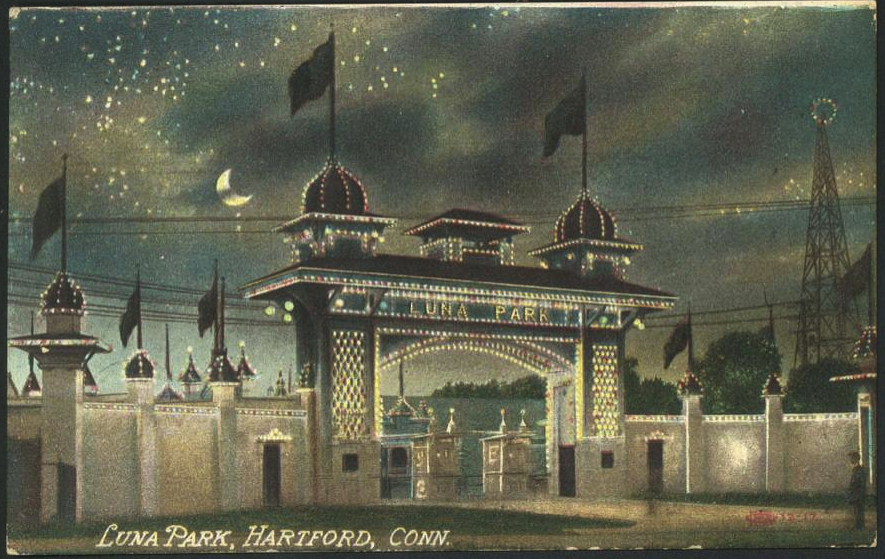The story of Luna Park in West Hartford provides insight into the battles between entertainment and ethics in Connecticut during the Progressive Era. Like many others across the country, Connecticut residents sought respite from their rapidly industrializing surroundings. They sought access to parks and shared a growing fascination with amusements. Unfortunately, this increased focus on leisure and recreation often clashed with traditional Puritan values in a state that often resisted social change.
West Hartford Follows Amusements Trend but Runs Afoul of Conservative Laws
At the start of the 20th century, the success of attractions like New York’s Coney Island and Connecticut’s Savin Rock Park and Lake Compounce led to the creation of Luna Park in West Hartford. Offering visitors a Ferris wheel, a miniature train ride, and numerous other attractions, the park gained notoriety for the challenges it posed to a number of conservative state laws.
In 1906, the Chatford Company, which owned Luna Park, faced considerable opposition to its policy of operating on Sundays. At the time, Connecticut’s Sunday law prohibited “any secular business or labor, except works of necessity or mercy” on the Christian sabbath day. The Reverend T. M. Hodgen of West Hartford claimed that the $200 licensing fee paid by the Chatford Company did not justify the humiliation the park brought to the town by so openly defying the law. The Reverend also claimed that the $50 fine imposed on Luna Park’s operators for violating the Sunday law was a small price to pay in comparison to the tremendous revenues the company raked in on Sundays.
Trolley Lines Bring Crowds to Park
When it came to applying state laws at Luna Park, enforcement proved haphazard at best. While a couple of peanut vendors faced prosecution in 1906 for trespassing on the grounds, little attention fell on the gambling and alcohol restrictions that went unenforced. Attendance at the park grew along with local revenues, and the construction of new trolley lines and the addition of new cars to existing lines helped bring as many as 5,000 visitors to Luna Park one Sunday in the spring of 1906.

The midway, circa 1908 – Connecticut Historical Society
Luna Upgrades its Image with Charity Events
In 1908, Luna Park bolstered its image when it hosted a benefit for Hartford Hospital. The benefit raised money by providing circus acts, charging visitors 25¢ to roller skate and $1 per couple to dance. Among the more popular events were automobile competitions for both men and women drivers. While men competed against each other by balancing their automobiles on giant seesaws and driving while attempting to dress themselves, women drove through obstacle courses and competed in “bouquet races” in which they dashed to gather flowers and then get their cars to the finish line.
Still, despite its success, the moral battles continued. By the end of the decade, the Good Citizenship League of West Hartford monitored the activities of the park closely. They made note of any illegal instances of dancing, pool playing, roller skating, or gambling they witnessed. In 1910, despite limited success on other fronts, moral crusaders did manage to get a ban placed on Sunday moving picture shows in Luna Park.
After enjoying tremendous success hosting state fairs (including one in 1915 that brought an estimated opening-day crowd of 75,000 people), Luna Park suffered sharp declines in business when the Great Depression hit. Additionally, the growing presence of automobiles meant that travelers began bypassing rail and trolley line attractions for more distant destinations. Ultimately, the park met its demise in the 1930s when demolition crews razed it to make way for a new Pratt & Whitney factory, which later became a part of Colt Industries. Today, the location of Luna Park is home to a sprawling Home Depot store.









